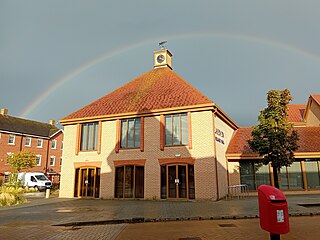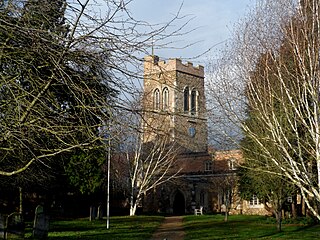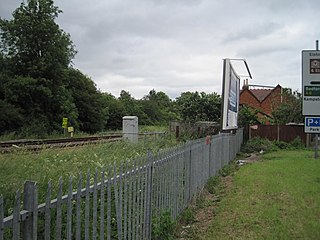
Bedford is a market town in Bedfordshire, England. At the 2011 Census, the population of its urban area, including Kempston and Biddenham, was 106,940. Bedford is also the county town of Bedfordshire and seat of the Borough of Bedford, a unitary authority that includes a significant rural area.

Kempston is a town and civil parish in the Borough of Bedford, Bedfordshire, England, situated around 2 miles (3.2 km) south-west of Bedford town centre. It had a population of 19,330 in the 2011 census, and forms part of the wider Bedford built-up area. The River Great Ouse separates it from the Queen's Park area of Bedford.

Little Barford is a hamlet and civil parish in the Borough of Bedford in Bedfordshire, England about 7 miles (11 km) northeast of the county town of Bedford.

The Borough of Bedford is a unitary authority area with borough status in the ceremonial county of Bedfordshire, England. Its council is based in Bedford, its namesake and principal settlement, which is the county town of Bedfordshire. The Bedford built-up-area is the 71st largest in the United Kingdom and comprises the boundaries of the pre-1974 Bedford Municipal Borough, the town of Kempston and the village of Biddenham, with the BUA surrounded by a rural area with many villages. 75% of the borough's population live in the Bedford Urban Area and the five large villages which surround it, which makes up slightly less than 6% of the total land area of the Borough.

Bedford is a constituency represented in the House of Commons of the UK Parliament since 2017 by Mohammad Yasin of the Labour Party.

Mid Bedfordshire is a constituency represented in the House of Commons of the UK Parliament by Alistair Strathern of the Labour Party since a 2023 by-election.

Stewartby is a model village and civil parish in Bedfordshire, England, originally built for the workers of the London Brick Company. The village was designed and built to the plans of the company's architect Mr F W Walker, laid out on 'Garden City' principle, a later and more modern development than such better-known Victorian model villages as Saltaire. Started in 1926, Stewartby is also a later model than Woodlands which was first planned in 1905. The later retirement bungalow development of the 1950s and 1960s with the pavilion community centre in their midst was designed by the neo-Georgian architect Professor Sir Albert Richardson. Today, Stewartby parish also includes Kempston Hardwick.

Kempston Rural is a civil parish in the Borough of Bedford in Bedfordshire, England.
Bedford Rural District was a rural district in Bedfordshire, England from 1894 to 1974. It surrounded but did not include the Municipal Borough of Bedford and Kempston Urban District.

Stewartby railway station is a station on the London Northwestern Railway, which serves the Bedfordshire village of Stewartby in England. It is the nearest station to the Marston Vale Millennium Country Park.

Kempston Hardwick railway station serves the village of Kempston Hardwick in Bedfordshire, England. It should not be confused with the nearby town of Kempston. The station has two platforms next to a half-barrier level crossing.

North Bedfordshire was a county constituency in Bedfordshire. It returned one Member of Parliament (MP) to the House of Commons of the Parliament of the United Kingdom, elected by the first-past-the-post voting system.

Marston Vale is an area of Bedfordshire. It lies to the south west of Bedford and Kempston, near Junction 13 of the M1 motorway. Historically it was one of the main brickmaking districts in England, home of the London Brick Company, now a division of Hanson plc. The brickmaking activity left scars across the landscape of the Marston Vale as large tracts of land were dug for clay. Most of the claypits are now exhausted, and most of the brickmaking chimneys have been demolished. The legacy of the abandoned brickworks also adds to the impression that the Marston Vale has been despoiled by decades of industrial activity and it is now searching for a new identity. In more recent years the local authorities have taken the opportunity to reuse the clay pits for landfills at Stewartby and Brogborough, both of which are recently capped and closed down.

Wixams is a new town and civil parish located in Bedfordshire, England, which has been under construction since early 2007. It is expected to become the third largest settlement in the Borough of Bedford after Bedford itself and Kempston, and one of the largest new settlements founded in England since the British new towns movement of the first twenty five years after World War II.

Southill is a rural village and civil parish in the Central Bedfordshire district of the county of Bedfordshire, England; about 8 miles (13 km) south-east of the county town of Bedford.

Kempston & Elstow Halt was a railway station on the Varsity Line which served the Bedfordshire town of Kempston in England. Opened in 1905, it was closed temporarily during both world wars and did not reopen after 1941, being officially closed in 1949.

Wootton Broadmead Halt was a railway station on the Varsity Line which served the settlement of Wootton Broadmead near Stewartby in Bedfordshire, England. Opened in 1905, it was closed temporarily during both world wars and did not reopen after 1941, officially closing in 1952.
Kempston was an urban district in Bedfordshire, England between 1896 and 1974.

















